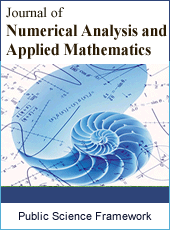Journal of Numerical Analysis and Applied Mathematics
Articles Information
Journal of Numerical Analysis and Applied Mathematics, Vol.1, No.1, Sep. 2016, Pub. Date: Jul. 27, 2016
Singularity Minimization, Reduction and Penetration
Pages: 6-13 Views: 4818 Downloads: 1345
[01]
Timothy Sands, Mechanical Engineering Department, Stanford University, Stanford, USA.
[02]
Jae Jun Kim, Mechanical and Aerospace Engineering Department, Naval Postgraduate School, Monterey, USA.
[03]
Brij Agrawal, Mechanical and Aerospace Engineering Department, Naval Postgraduate School, Monterey, USA.
Two objectives dominate consideration of control moment gyroscopes (CMGs) for spacecraft maneuvers: High torque (or equivalently momentum) and singularity-free operations. Utilizing a 3/4 CMG skewed-pyramid the optimal singularity-free configuration is revealed. Next, this paper develops a decoupled control strategy to reduce the remaining singular conditions. Analysis and simulation is provided to justify the argument with experimental verification performed on a free-floating satellite simulator. Furthermore, a singularity penetration algorithm is developed, simulated, and experimentally proven to fly through singularities even without singularity reduction.
Singularity, Inversion, Deficient, Jacobi, Singularity Reduction, Singularity Minimization, Singularity Penetration
[01]
D. J. Liska and Jacot Dean, “Control moment gyros”, AIAA Second Annual Meeting Paper Preprint Number 65-405, July 1965.
[02]
B. D. Elrod, G. M. Anderson, “Equilibrium properties of the skylab CMG rotation law-Case 620”, NASA-CR-126140 (Bellcomm TM-72-1022-2), p. 79, 1972.
[03]
H. F. Kennel, “Steering law for parallel mounted double-gimbaled control moment gyros”, NASA-TM-X-64930, p. 34, 1975.
[04]
B. K. Colburn and L. R. White, “Computational considerations for a spacecraft attitude control system employing control moment gyro”, Journal of Spacecraft, Vol. 14, No. 1, p. 40-42, 1977.
[05]
T. Yoshikawa, “A Steering law for three double gimbal control moment gyro system”, NASA-TM-X-64926, 1975.
[06]
H. F. Kennel, “Steering law for parallel mounted double-gimbaled control moment gyros”, NASA-TM-X-82390, p. 22, 1981.
[07]
Magulies and J. N. Aubrun, “Geometric theory of single-gimbal control moment gyro system”, Journal of Astronautical Sciences, Vol. 26, No.2, pp. 159-191, 1978.
[08]
E. N. Tokar, “Problems of gyroscopic stabilizer control”, Cosmic Research, pp. 141-147, 1978 (original: Kosmicheskie Issledovaniya Vol. 16, No. 2, pp. 179-187, 1978).
[09]
Haruhisa Kirokawa, “A Geometric study of single gimbal control moment gyroscopes”¸ Technical Report of Mechanical Engineering Lab No. 175, June 7, 1997.
[10]
D. E. Cornick, “Singularity avoidance control laws for single gimbal control moment gyros, Proceedings of AIAA Guidance and Control Conference 79-1968, pp. 20-33, 1979 (Martin Marietta Corp.).
[11]
Kurokawa, N. Yajima, and S. Usui, “A CMG attitude control system for balloon use”, Proceedings of 14th International Symposium on Space Technology and Science (ISTS), pp. 1211-1216, 1984.
[12]
Kurokawa, N. Yajima, and S. Usui, “A New steering law of a single gimbal CMG system of pyramid configuration”, Proceedings of IFAC Automatic Control in Space, pp. 251-257, 1985.
[13]
S. R. Bauer, “Difficulties encountered in steering single gimbal CMGs”, Space Guidance and Navigation Memo No. 10E-87-09, The Charles Stark Draper Laboratory, Inc.
[14]
NASA MSFC, “A Comparison of CMG steering laws for high energy astronomy observatories (HEAOS)”, NASA TM X-64727, p. 127, 1972.
[15]
N. S. Bedrossian, “Steering law design for redundant single gimbal control moment gyro systems”, NASA-CR-172008 (M.S. Thesis of Massachusetts Institute of Technology, CSDL-T-965), p. 138, 1987.
[16]
N. S. Bedrossian, J. Paradiso, E. V. Bergmann, D. Rowell, “Steering law design for redundant single-gimbal control moment gyroscope”, AIAA Journal of Guidance, Control, and Dynamics, Vol. 13, No. 6, pp. 1083-1089, 1990.
[17]
G. Magulies and J. N. Aubrun, “Geometric theory of single-gimbal control moment gyro system”, Journal of Astronautical Sciences, Vol. 26, No. 2, pp. 159-191, 1978.
[18]
S. P. Linden, “Precision CMG control for high-accuracy pointing”, Proceedings of AIAA Guidance and Control Conference, AIAA No. 73-871, p. 7, 1973.
[19]
S. C. Rybak, “Achieving ultrahigh accuracy with a body pointing CMG/RW control system”, Proceedings of AIAA Guidance and Control Conference AIAA No. 73-871, p. 7, 1973.
[20]
S. R. Vadali, H. S. Oh, and S. R. Walker, “Preferred gimbal angles for single gimbal control moment gyros”, Journal of Guidance, Vol, 13, No. 6, pp. 1090-1095, Nov-Dec 1990.
[21]
S. M. Seltzer, “CMG-induced LST dynamics”, NASA-TM-X-64833, p. 80, 1974.
[22]
S. P. Linden, “Precision CMG control for high-accuracy pointing”, Proceedings of AIAA Guidance and Control Conference, AIAA No. 73-871, p. 7, 1973.
[23]
S. C. Rybak, “Achieving ultrahigh accuracy with a body pointing CMG/RW control system”, Proceedings of AIAA Guidance and Control Conference AIAA No. 73-871, p. 7, 1973.
[24]
Bong Wie, Space Vehicle Dynamics and Control, pp. 439, AIAA, 1998.
[25]
Sands, TA; Kim JJ, Agrawal, BN., “2H Singularity-Free Momentum Generation with Non-Redundant Single Gimbaled Control Moment Gyroscopes”, Proceedings of 45th IEEE Conference on Decision and Control (CDC), San Diego, CA, Dec. 2006, IEEE Paper # CDC06_1236_MS.
[26]
Sands, T., Kim, J. J., Agrawal, B. N., "Nonredundant Single-Gimbaled Control Moment Gyroscopes," Journal of Guidance, Control, and Dynamics, 35(2) 578-587, 2012.
[27]
Sands, T., Kim, J., Agrawal, B. "Method and Apparatus for Singularity Avoidance for Control Moment Gyroscope (CMG) Systems Without Using Null Motion", Patent Pending (61/840,010), June 27, 2013.
[28]
Sands, T., Kim, J., Agrawal, B., "Experiments in Control of Rotational Mechanics", International Journal of Automation, Control and Intelligent Systems, 2(1) 9-22, Jan. 2016.
[29]
Nakatani, S., Sands, T., "Autonomous Damage Recovery in Space", International Journal of Automation, Control and Intelligent Systems, Accepted for (2)2, Jul. 2016.
[30]
Sands, T., "Physics-Based Control Methods," book chapter in Advancements in Spacecraft Systems and Orbit Determination, In-Tech Publishers, pp. 29-54, 2012.

ISSN Print: Pending
ISSN Online: Pending
Current Issue:
Vol. 2, Issue 2, March Submit a Manuscript Join Editorial Board Join Reviewer Team
ISSN Online: Pending
Current Issue:
Vol. 2, Issue 2, March Submit a Manuscript Join Editorial Board Join Reviewer Team
| About This Journal |
| All Issues |
| Open Access |
| Indexing |
| Payment Information |
| Author Guidelines |
| Review Process |
| Publication Ethics |
| Editorial Board |
| Peer Reviewers |


